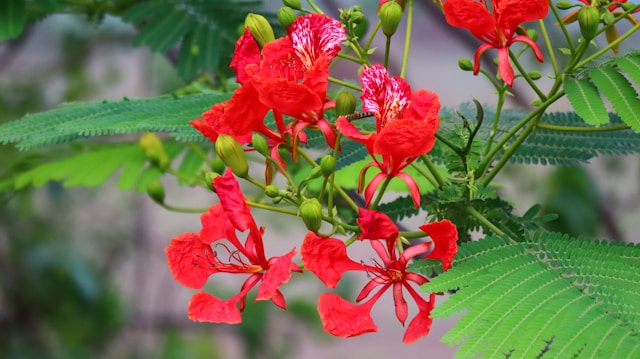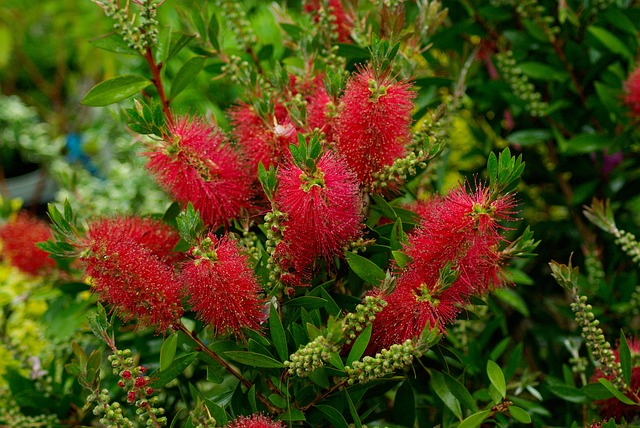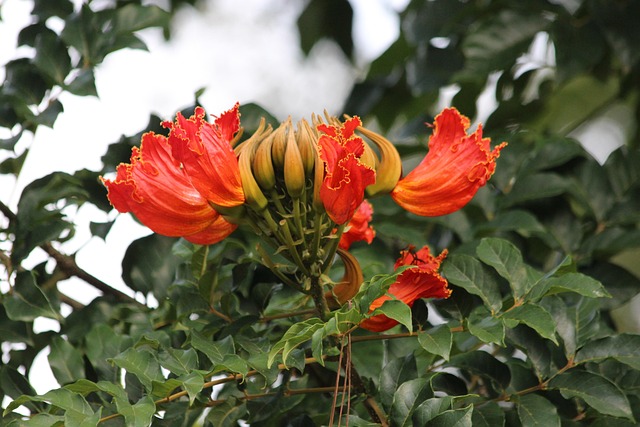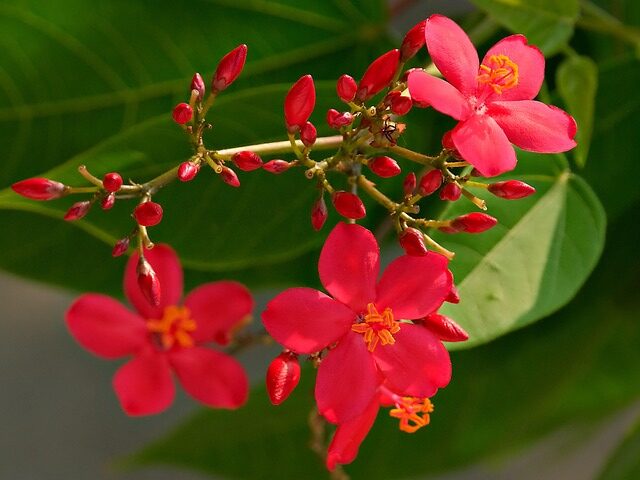
There’s something unforgettable about red flowers. Bold, bright, and bursting with energy, they symbolize love, strength, and passion. When red flowers bloom on towering trees, the effect is nothing short of breathtaking. In Pakistan, several trees put on a spectacular show with red blooms—whether they’re lining streets, shading parks, or adding drama to a garden landscape.
This blog will take you on a tour of the most beautiful and widely planted red flower trees in Pakistan. From the dazzling Gulmohar to the rare African Tulip, these trees don’t just add color—they transform spaces into vibrant works of art.
If bold colors excite you, you may also want to check out the 7 Best Pink Flowering Trees in Pakistan for soft, romantic tones.
Table of Contents
ToggleBest Red Flowering Trees in Pakistan
Gulmohar (Delonix regia- گل مہر)
The undisputed king of red flowering trees in Pakistan, Gulmohar, also known as Flamboyant Tree or Flame Tree, is loved for its fiery red-orange flowers that bloom in abundance.
- Height: 6–12 meters
- Bloom Time: Late spring to early summer (May–July)
- Features: Spreading branches, umbrella-like canopy, feathery leaves
- Best For: Parks, avenues, large gardens
- Care Tips: Needs full sun and well-drained soil; drought-resistant once established
When in full bloom, Gulmohar looks like it’s on fire—its branches almost hidden under clusters of scarlet flowers. It also provides ample shade and creates a stunning contrast with its fern-like foliage.

Bottlebrush Tree (Callistemon citrinus- بوتل برش)
Named after the shape of its flowers, the Bottlebrush Tree is a popular choice for urban gardens. Its red, bristly flowers resemble bottle-cleaning brushes and are a magnet for birds and bees.
- Height: 6-8 meters
- Bloom Time: Spring and autumn
- Features: Cylindrical red flower spikes, evergreen narrow leaves, low maintenance
- Best For: Small gardens, fences, roadsides
- Care Tips: Requires full sun, occasional pruning, and well-drained soil
This compact, hardy tree is perfect for spaces where you want eye-level beauty and pollinator activity.
Curious about other bright options? Take a look at the Best Yellow Flower Trees in Pakistan to add sunshine to your space.

Indian Coral Tree (Erythrina variegate- پنگارہ)
Locally known as Pangara, the Indian Coral Tree produces thick clusters of bright red, coral-shaped flowers that bloom before the leaves appear—creating a striking silhouette.
- Height: 15-20 meters
- Bloom Time: Late winter to early spring
- Features: Thorny trunk, large trifoliate leaves, coral-like red flowers
- Best For: Large gardens, rural roadsides, public spaces
- Care Tips: Deciduous in winter; prune in summer; likes full sun
The tree is also traditionally valued for its medicinal uses and is often found near shrines and farms.

African Tulip Tree (Spathodea campanulate- افریقن ٹیولپ)
This exotic beauty is known for its large, tulip-shaped red to reddish-orange flowers that bloom in clusters and resemble flames from a distance.
- Height: 10–18 meters
- Bloom Time: Spring and summer
- Features: Large glossy leaves, cup-shaped red flowers with golden edges
- Best For: Avenue planting, tropical gardens, estates
- Care Tips: Prefers moist, fertile soil and full sun
The African Tulip Tree is a fast-growing species that offers both dramatic flowers and thick foliage, though it requires regular care in its early years.
Explore even more blooming choices in our 14 Best Flowering Trees in Pakistan.

Red Silk Cotton Tree (Bombax ceiba- سمبل)
Known as Sumal in Pakistan, this tree sheds all its leaves in winter and bursts into bloom with enormous red flowers just before spring, creating a spectacular scene.
- Height: Up to 30 meters
- Bloom Time: February to April
- Features: Thick trunk with conical spines, large five-petaled red flowers
- Best For: Large gardens, rural landscapes, forest borders
- Care Tips: Tolerates poor soils, needs space due to its large size
These flowers are not only visually stunning but also attract birds like mynas, parrots, and sunbirds.

Jatropha Tree (Jatropha integerrima- جتروفہ)
Though smaller in stature, the Jatropha Tree offers bright red star-shaped flowers almost year-round, making it a favorite for ornamental planting.
- Height: 5-6 meters
- Bloom Time: Nearly year-round in warm climates
- Features: Clusters of scarlet flowers, deep green foliage, compact form
- Best For: Courtyards, patios, pots, borders
- Care Tips: Loves heat and sun; keep pruned for shape
Jatropha is also considered a good nectar source for butterflies and is ideal for compact landscapes.

Why Red Flowering Trees?
Red flowers naturally draw attention. But beyond their visual appeal, red flowering trees offer several benefits:
🔥 Bold Landscaping Statement – Red adds drama and excitement to any space.
🐝 Pollinator-Friendly – Many red flowers are rich in nectar, attracting birds and bees.
🌳 Seasonal Beauty – Trees like Gulmohar and Coral Tree light up dry seasons with color.
🌿 Variety of Sizes – From towering giants like Silk Cotton to compact beauties like Jatropha.
Tips for Growing Red Flower Trees in Pakistan
✔ Sunlight is Essential: Most red flowering trees require full sun for maximum blooming.
✔ Choose the Right Spot: Ensure enough space for the tree’s mature size.
✔ Water Wisely: Water regularly when young; reduce frequency once established.
✔ Prune for Shape: Light pruning after blooming promotes healthy growth and shape.
✔ Watch for Pests: Some species (like Bottlebrush) may attract aphids—check leaves regularly.
Landscaping Ideas with Red Flower Trees
🌺 Garden Centerpiece: Use a Gulmohar or African Tulip as a bold visual anchor in large gardens.
🪵 Tropical Border: Mix Jatropha with yellow and pink flowering trees for a vibrant color mix.
🛤 Avenue Planting: Line wide roads with Coral Trees or Silk Cotton for a stunning spring display.
🌼 Wildlife Garden: Plant Bottlebrush near a birdbath to attract hummingbirds and bees.
Red flower trees bring fiery energy and elegance to Pakistan’s diverse landscapes. Whether you’re designing a home garden, city park, or farm boundary, these trees offer beauty, biodiversity, and bold seasonal displays.
From the iconic Gulmohar and its flame-like flowers to the more unusual African Tulip and Red Silk Cotton trees, the choices are as varied as they are vibrant. With just a little planning and care, you can enjoy these natural fireworks year after year.
